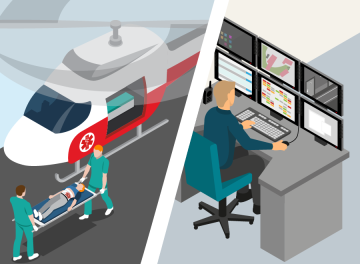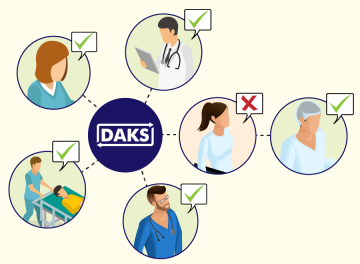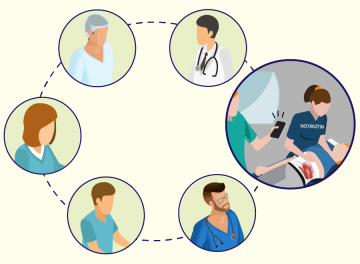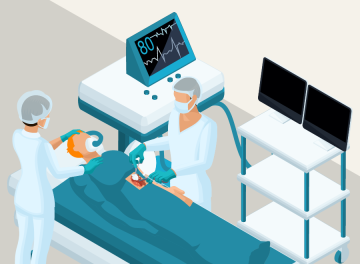© tetronik GmbH. All rights reserved.
© tetronik GmbH. All rights reserved.
Organize Emergency Operations Quickly and Effectively
When things get critical, emergency surgeries must be performed immediately
Whether it's a ruptured appendix, an emergency C-section or a car accident, emergency surgeries must always be initiated when human lives are acutely at stake, and they rarely do so punctually at a convenient time when the right doctor just happens to have an open slot. Usually, the organizational processes in surgical areas are characterized by tight operating schedules coinciding with frequent and more often than not short-notice changes.
Surgical coordinators walk the tightrope between including sufficient buffer time for sudden emergencies and maximizing the overall use of their surgical facilities by scheduling known operations. A single emergency can entail several hundred phone calls and messages for the coordinator before all necessary new planning and rescheduling is accomplished to the last detail.
Automating these extensive communication tasks can significantly speed up and simplify the entire organizational processes.

This is how you handle the organization of emergency surgeries at the touch of a button

When an emergency requires more than a space blanket
After a serious accident, the ambulance men are already at the scene. Initial correspondence between the emergency paramedics on site and the dispatcher at the hospital's control center shows that the condition of individual accident victims will require emergency surgeries. The hospital's operating schedule must now be restructured as quickly as possible so that the severely injured patients can be operated on as soon as they arrive.

One mouse click triggers the entire process
On their user interface, the person responsible in the hospital's control center can trigger all communication tasks that arise in the context of surgical coordination at the click of a mouse.
The DAKS alarm server works seamlessly with the contact details and process descriptions that are already stored in the hospital's management system to reliably notify and assemble the necessary surgical team members. Important details such as the specification of the operating room and the type of surgery are provided, too.

DAKS provides for complete teams
DAKS automatically calls every person that is listed in the system's proxy regulations until it has successfully mobilized the complete emergency surgical team that is needed for the situation. This ensures that everyone is there in time and ready for the patient. This procedure can be monitored on the PC screen of the person who triggered the process and is also fully logged, including every confirmation received from the alerted professionals (e.g. "I am available" or "Unable to attend").
Additional personnel, such as those needed to pick up and transport emergency patients from the helicopter to the trauma room, are also mobilized by DAKS.

The surgical team is well prepared
When needed, DAKS intervenes directly from within the broadcast process to switch all responders into an emergency telephone conference. This way, important information like updates on the patient's condition can be shared between the members of the surgical team at the hospital and the paramedics in the helicopter. In the trauma room of the surgical emergency department, the handover from the emergency paramedic to the waiting surgical team can be even faster and more targeted thanks to this preliminary telephone call.

The emergency surgery can be performed immediately
An emergency surgery has immediate repercussions on the regular operating room schedule. DAKS automates any communication processes that inevitably result from this reorganization. This includes the surgeon who has to interrupt their ongoing operation to quickly vacate the operating room for the emergency procedure, the surgical team whose scheduled operation must be postponed and the transport service team who had already been on their way to the operating room with another patient. Notifying all parties affected by the rescheduling without delay alleviates many stressful situations, adds increased synergy for all those affected and helps to return to the routine hospital operation as quickly as possible.
Benefits of putting together emergency surgery teams automatically

Relief for the clinic staff
- The strain on staff and the overall stress level are effectively decreased.
- The risk isk of stress-induced wrong health care decisions and medical malpractice are minimized.

Fast and appropriate help for the patients
- Doctors can agree on which equipment and which procedure will be needed for the surgery in advance.
- Severely injured patients can be treated effectively more quickly.

Efficiency and security for those responsible
- The detailed logging of communication processes is of great value for the optimization of internal processes and also for legal certainty.
- Workloads can be better distributed.
Discuss your individual
application project with us
Add this solution
to your shortlist
Related Application Examples

Automate Trauma Room Alerting

Design IoT Workflows in Nursing More Securely

Alarm Management in Intensive Care Units
- Home
- Applications
- Healthcare
- Organize Emergency Operations Quickly and Effectively
© tetronik GmbH. All rights reserved.





